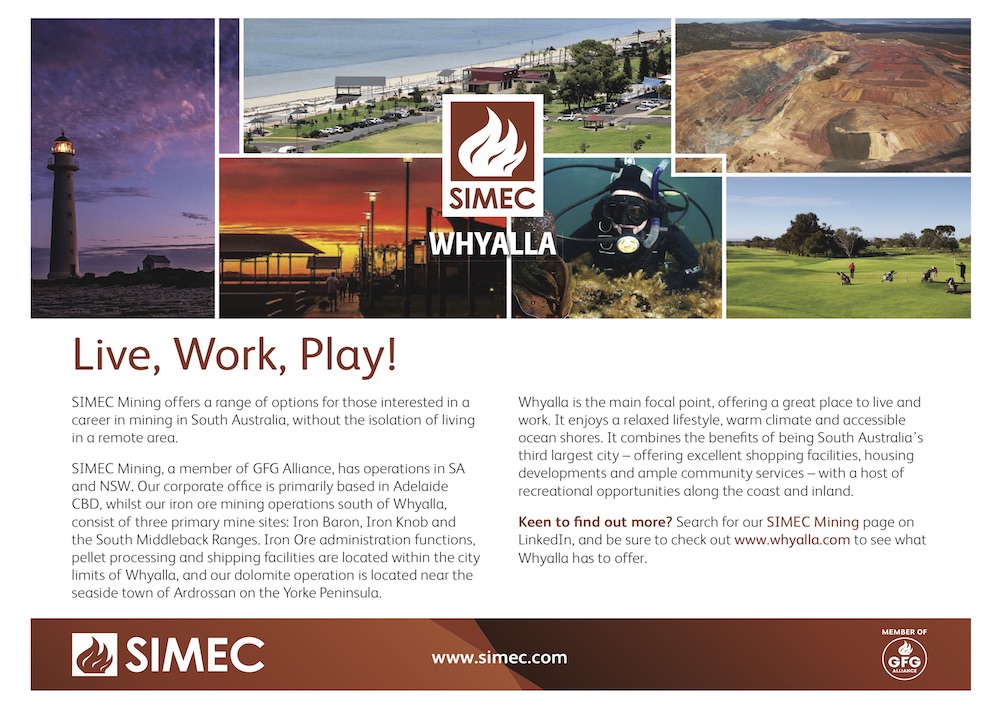Magnetite Transformation
SIMEC Mining is transitioning its focus to create new opportunities for future production
For more than a century, the Middleback Ranges have proven a rich source of hematite iron ore for use in the nearby Whyalla Steelworks, as well as supporting nearly 100 million tonnes in export sales into the Asian market in recent years. However, as this hematite resource has edged closer to the end of its illustrious life, SIMEC Mining has transitioned its focus toward the future, which will centre on its newly defined magnetite resource.
Recent exploration activities have identified a magnetite exploration target and resource in the Middleback Range that creates an opportunity for the company to build a project of both scale and longevity. SIMEC is investigating a number of exciting and innovative techniques to capitalise on this abundant magnetite resource, helping ensure the sustainability of its operations for decades to come.
SIMEC Mining’s general manager technical and innovation, Gavin Hobart, says shifting SIMEC’s thinking from the traditional flowsheet to new applications of processing has created the potential to redefine what the business could define as ‘ore’. “In the past 12 months, this has allowed us to more than treble our magnetite resource base to 443Mt, while continuing to provide further definition to our exploration targets that have the potential to more than double this again,” Hobart says.
“The quality and quantum of our magnetite resource – all within close proximity to our existing infrastructure, community, and port – provides a strong platform to transform our cost base, positioning us to create a more robust and sustainable future that can weather the cyclical nature of the commodity market. That puts us in an exciting position that we’re very keen to explore.”
Shifting to a magnetite-focused future for the Middleback Range provides SIMEC with the opportunity to simplify and optimise operations and supply chain activities, which currently cater for multiple operations and products. This creates a far more effective and efficient workflow design.
Some of the game-changing options SIMEC is investigating include the integration of dry processing technologies for water saving; leveraging the sustainable energy options within the region for lower-cost power; and adopting some new impurity removal processes.
“Work to-date has demonstrated that these processes allow us the flexibility to adapt our market product from the current high-grade blast furnace specification concentrate and pellet, to an even higher-premium direct reduction (DR) quality,” Hobart says. “This level of flexibility in the process to optimise our product to cater for a broader scope of customer and create premium products is highly desirable.
“This is also important for the Whyalla Steelworks, as it considers a number of different options for its transformed configuration.”
While these ideas are only in the concept and pre-feasibility stages, the magnetite resource is now tangible, justifiably creating optimism for the long-term. “Significant test work is ongoing, providing us confidence in the benefits of the technologies and concepts we’re considering, so it’s very encouraging,” Hobart says.
SIMEC is currently undertaking pre-feasibility of expanding its current magnetite operation from 2Mtpa to a (nominally) 5Mtpa operation, targeting a full feasibility study in FY22. In parallel, a further concept study is investigating building on this toward a 10-15Mtpa operation.
“This scale would go a long way to underpin our Executive Chairman Sanjeev Gupta’s vision for a 10-million-tonne Whyalla Steelworks, although it could also exist independently due to the significant interest in the product right across Asia,” Hobart says.
